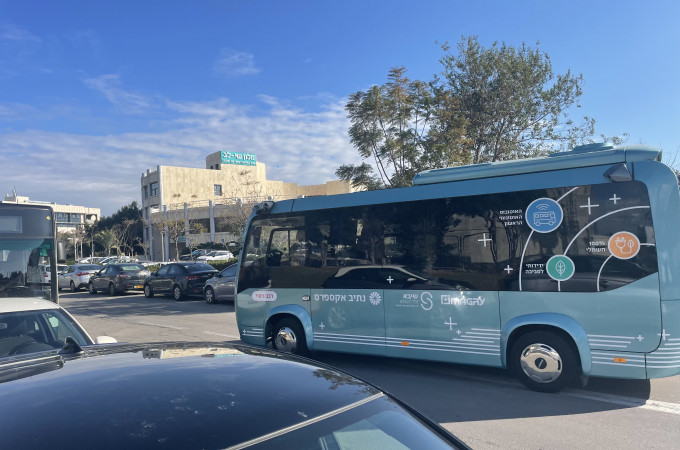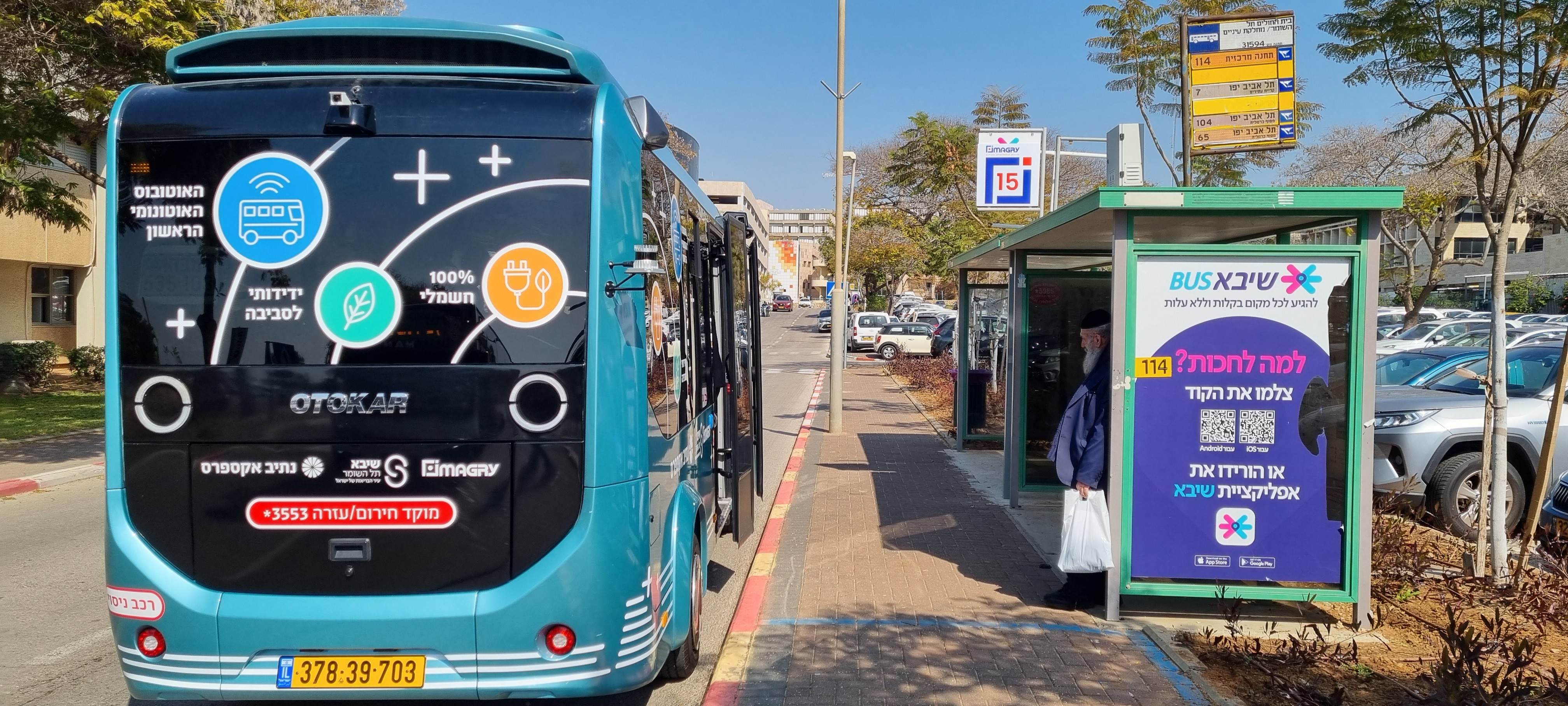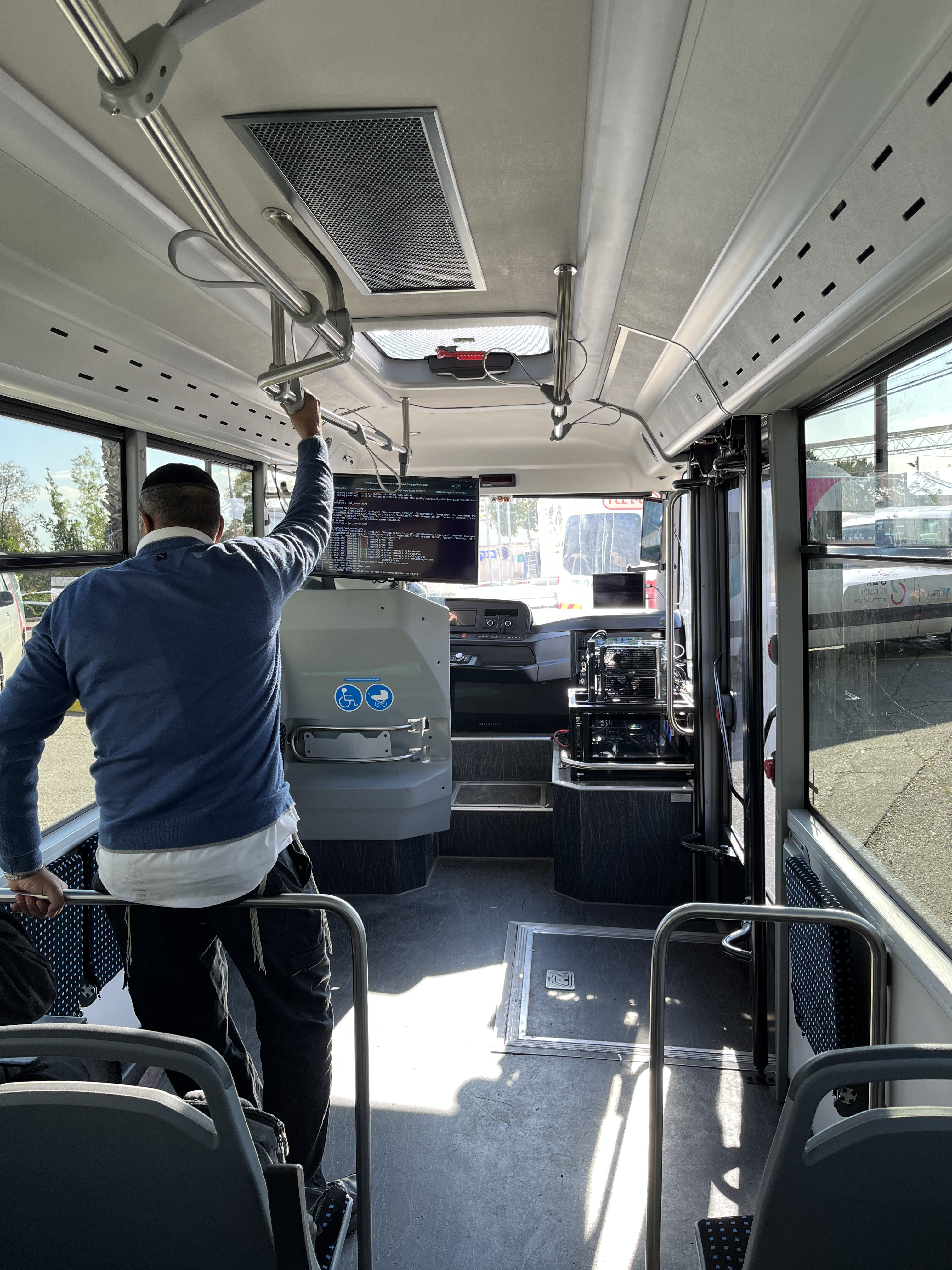Self-driving in the startup nation: T&BB interviews Eran Ofir, CEO of Israeli company Imagry
By Bradley Osborne - 12th September 2023

Self-driving bus in the Sheba Medical Center
Israel – Why do tech startups tend to concentrate in certain countries and regions? Or, to put it another way, why are some places more favourable to the growth of new companies than others? These are questions that bear greater relevance to the commercial vehicle industry today, as manufacturers search for partners to work with on the digital technologies which will make our trucks and buses smarter and more connected. They are also relevant to conversations which I had with Eran Ofir, CEO of an autonomous driving technology startup called Imagry, founded in Haifa, Israel: a country with a relatively small population and no automotive manufacturing to speak of, yet with massive potential to direct the future of road transportation.
Israel is known as the “startup nation”, following the publication of a book of that name in 2009. Ofir told me that, as of today, there are 600 startups in the automotive domain in Israel, working on interfaces, safety systems, and “smart cities” for all types of road vehicle. To the first appellation, Ofir added a second, “cyber country”, referring to the state’s proactive adoption of the latest standards and protocols in cybersecurity. This is just one of many factors that give Israel the edge when it comes to tech innovation. The coastal plain surrounding the city of Tel Aviv is nicknamed “Silicon Wadi” and is touted as a competitor to its namesake in California.
The city of Haifa lies outside of Silicon Wadi, and Ofir breezily explained that Haifa is “where the founding team was from”, so it has remained there. In fact, the city is a self-contained tech hub with manufacturing and research and development facilities owned by big names such as Apple, Microsoft, and Amazon. Today, Imagry has its headquarters in San Jose, California, and it has conducted tests of autonomous cars on roads in the United States and Germany as well as in Israel. Only very recently has it begun testing its software with buses, based on a partnership with Turkish manufacturer Otokar.
Imagry’s successes in attracting partners and investors have a lot to do with the unique advantages of doing business in Israel, but they also have to do with the company’s singular approach to making self-driving vehicles which are safe and reliable. Its software is “mapless”: that is to say, any vehicle fitted with Imagry’s technology does not require any preinstallation of high-definition street maps of the area(s) it operates in. Instead, as Ofir explained, the vehicle drives “like you or I do”: it perceives objects in its environment, differentiates between different road users, and identifies potential risks, thus building up a dynamic “map” of its surroundings. The benefits of this approach include greater adaptability to unforeseen challenges (e.g., roadworks, loss of GPS connection, etc.), lower cost, and faster rollout of vehicles with self-driving enabled.
Ofir has high ambitions for the company. He expects there to be over a thousand buses in Israel alone with autonomous capabilities up to Level 4 by 2030. Moreover, the company recently started working with Continental on integrating autonomous parking into mass-produced passenger cars. Beyond Israel, Imagry is targeting markets and partners in the U.S., Europe, and the Asia-Pacific region. Ofir is himself an experienced businessman with multiple successful startups to his name. He harboured no doubts whatsoever about Imagry’s potential to ride the crest of the digital wave sweeping across the automotive industry.

Otokar bus installed with Imagry self-driving technology
Principles of Imagry’s technology
To understand the principles of the artificial intelligence employed by Imagry in its self-driving technology, we need to turn to a biological analogy. The nervous system in an animal is made up of neurons which send electric signals between each other to perform certain functions. Neurons enable us to respond to external stimuli (light, sound, etc.), to control parts of our body by activating muscles, and to have thoughts. Webs of multiple connected neurons are called “neural networks”. Connections between neurons can be “excitatory” or “inhibitory”, i.e., they can activate or prevent a particular action or reaction.
An artificial neural network emulates the form of its biological counterpart. Every part of the network is analogous to a neuron and has an assigned function. In the case of a self-driving system, this means that one part or “node” is responsible for looking at traffic lights, while another is responsible for identifying pedestrians, and so on. With the accumulated data, the system builds, in real time, a three-dimensional map of the vehicle’s environment, up to a radius of 200 metres – not unlike how the brain takes external stimuli to build up a visual and aural representation of the animal’s surroundings.
The self-driving software needs to be able to identify and appropriately react to road users and objects in the vehicle’s environment. For this, Imagry employs a “convolutional neural network”. This kind of software architecture is designed to process visual data and can be used to teach image recognition to a software programme. Imagry’s self-driving software is “a system that teaches itself how to drive and learns from its mistakes”, explained Ofir.
These principles of the software design explain why Imagry’s autonomous vehicles can operate without preinstalled high-definition maps. Drawing on visual data from cameras placed around the vehicle, the software creates a virtual representation of its surroundings on the fly and applies the rules of engagement with other road users and traffic infrastructure which it has learned through repeated testing. “This is what takes time,” admitted Ofir, referring to the machine learning through the neural networks, “a lot of time.” But he feels that the work is paying off. Now the software has been put through its paces, Imagry is finding that it can put vehicles on unknown roads while requiring very little time to adjust. In 2021, the company put a self-driving car on the road in Frankfurt in just three days with only minimal tweaks to the software. “It drove like it was born there,” said Ofir.
There are multiple advantages to driving without preinstalled HD maps. The Frankfurt case furnishes the main benefit: it takes very little time and effort to put a self-driving vehicle on the road in a new place. Not being reliant on maps also means that the vehicle is unaffected by the loss of a GPS signal. It is therefore more adaptable to unforeseen situations – for instance, to a blocked road requiring a detour to get around it. It is also a more flexible asset in the hands of a bus operator serving several routes with changing demands on the fleet.
Moreover, the vehicle is “location-independent”; that is to say, it can theoretically be put anywhere with only small adjustments required. When the company tested a car in Frankfurt, minor tweaks were made to the programme so it would drive in accord with German traffic laws. It had previously been driving in the United States, and so it needed to be told that it could not turn right on a red light in its new location.
Finally, Imagry’s self-driving technology is hardware agnostic. It can run on chipsets provided by any supplier, once Imagry does the work of migrating the software platform to the hardware configuration preferred by the OEM.

Inside the bus
Self-driving buses in Israel and beyond
Imagry has carried out tests with cars in Israel, the United States, and Germany over several years. It was only recently that the company turned its attention to buses for urban transportation. It won a bid to develop an autonomous bus for a two-year project at the Sheba Medical Center, a hospital district in Ramat Gan. The bus is now operating on the geofenced campus with transport provider Nateev Express. Another pilot is set to begin on public roads in the city of Nahariya.
Through these contracts, Imagry entered into a partnership with Otokar. Each bus is shipped out from Turkey to Israel, where Imagry carries out the work of integrating the autonomous driving hardware. They fit the system-on-a-chip – in this case, the ‘Orin Drive’ by Nvidia – with the self-driving software installed, as well as cameras, to convert the bus into an autonomous-ready vehicle.
Working with buses instead of cars has already proven to be much more straightforward for the company. A typical bus, self-driving or not, tends to drive more slowly as it makes frequent stops to pick up and drop off passengers. Moreover, it repeats the same route multiple times in a day, allowing the software to quickly master the roads and adapt to its new environment.
The main obstacle faced by pioneers such as Imagry is regulations (or the lack thereof) for self-driving vehicles, and it’s in this area where Israel has a decisive edge over other developed countries. Ofir claimed that only in Israel has a national government passed rules and standards for self-driving vehicles going up to Level 4 autonomy. In Europe, such vehicles will require an onboard supervisor at all times, and in jurisdictions such as the Netherlands and several of the United States, they are restricted to geofenced zones such as ports and campuses. Israel, on the other hand, has outlined a roadmap for rigorous testing of autonomous vehicles which will eventually allow them to enter public service without onboard supervision. First of all, the vehicle needs to be homologated – Ofir said Imagry’s bus was the first autonomous vehicle to pass Euro NCAP testing; then, it needs to pass cybertesting. Once these are completed, the bus can drive on the road and take passengers, while facing one more hurdle. Every bus model currently undergoing pilot testing must safely cover a combined distance of 100,000 kilometres with a safety driver onboard. Afterwards, Imagry may apply for approval pull the safety driver out and allow the buses to operate on their own.
Imagry is one of three companies (the others are Mobileye and Yandex) to receive permits from the Israeli Ministry of Transportation to carry out testing on public roads. The government has worked closely with Imagry to turn autonomous vehicles from concept to reality and has provided funding for the pilots through the Israel Innovation Authority. While the regulations it has laid down are stringent, it believes that putting Imagry’s technology through its paces will put the company at a distinct advantage over foreign competitors once other countries introduce their own requirements.
Meeting Israel’s strict cybersecurity laws has put certain limitations on the design of Imagry’s self-driving buses. I was told categorically that there would be “absolutely no way” to control them remotely. Unlike with trucks, where some have proposed that terminal tractors in ports, for example, could be controlled remotely by a human operator, cybersecurity regulations will not allow for remote control of a bus carrying passengers. The risk of a hacker taking over the vehicle and endangering the passengers and other road users is too grave. Nevertheless, Imagry acknowledges that the self-driving software may need to be remotely overridden in the event of an emergency. As such, it is implementing an instruction that will trigger a “minimal risk manoeuvre”, such as pulling over and stopping at the next safe spot, so that the problem can be addressed. Imagry can remotely monitor its vehicles from a control centre, and passengers have the means to directly communicate with the control centre in case of a crisis (such as a passenger in distress).
By the middle of next year, Ofir envisages that Imagry’s buses will be able to operate in Israel without onboard supervision. By the end of the decade, he predicts that the country will have over a thousand autonomous buses on its roads. It is a dizzying thought, running counter to more cautious predictions about the timeline of self-driving vehicles. But Israel is determined to be a “pioneer” in this field, and several factors have given it a head start over other nations. For one thing, it has a very robust cybersecurity regime, a legacy of the past century in which it has been invaded several times by its neighbours. It is also blessed by long stretches of dry and sunny weather, furnishing the same advantages for self-driving R&D that similar conditions have done in the southwest United States.
Like many other Israelis, Ofir began his career in the army, receiving his scientific training during his mandatory service. He took that experience into roles with numerous telecommunications companies, helping to build up mobile internet when that technology was in its nascence. In the 2010s, he moved between startups, one in smart grid billing, another in cloud-based point of sale, and one – which is still running as an independent firm – for remote patient monitoring over the cloud. Ofir has successfully built up and sold several companies, but for him, Imagry is different. “Even though I had all that previous experience, Imagry is the opportunity of a lifetime. That’s the reason why I moved to manage Imagry, to build it up.” He believes that the automotive industry is about to undergo two revolutions: one is the move to software-defined vehicles which will be updated “over the air”; and the second is the emergence of autonomous vehicles. These present lucrative business opportunities, but they also present formidable challenges. Of all the posited applications for self-driving vehicles, urban transportation is one of the toughest nuts to crack, and this is precisely why Imagry chose to focus on it. Solve that, and the rest should easily follow: “any company that can do autonomy in urban areas can do highway, but not the other way round.”

Eran Ofir is a Tel-Aviv University graduate in Electrical Engineering (BSc) and Finance-Marketing MBA. Ofir’s business career spans over two decades, covering sectors including telecommunications, utilities, retail, healthcare, and automotive. He is an entrepreneur with a proven track record of building up successful companies. Some of the businesses that Eran built and managed were acquired by Huawei, NEC and NCR, after reaching significant commercial scale.



